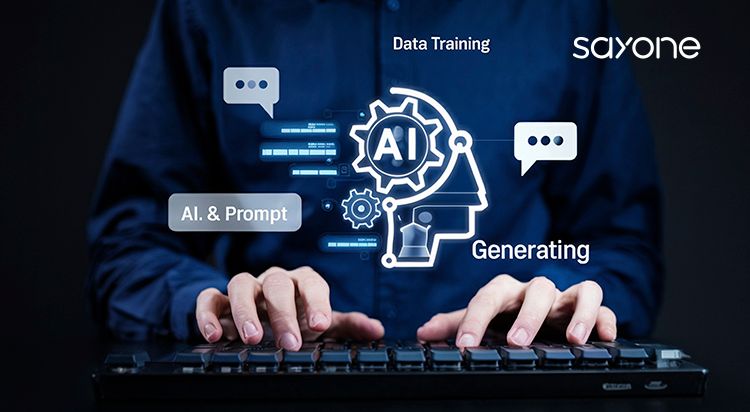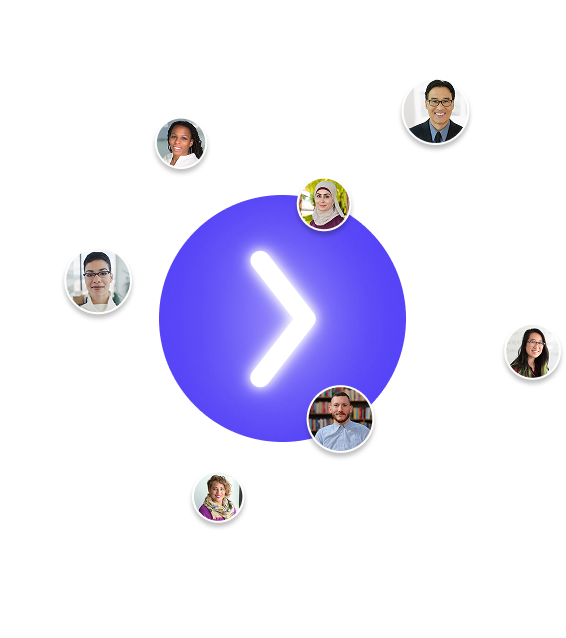
Subscribe to our Blog
We're committed to your privacy. SayOne uses the information you provide to us to contact you about our relevant content, products, and services. check out our privacy policy.

Ranju R April 29, 202512 min read

Generating table of contents...
Okay, let's talk about Generative AI. You've probably heard the term tossed around, maybe seen tools like ChatGPT or GitHub Copilot in action.
But what is it, really?
Generative AI isn't just analyzing data like older AI; it actually creates brand new content - text, code, images, you name it. It learns patterns from enormous datasets using complex neural networks, often called foundation models or LLMs, and then uses that understanding to generate something original.
Now, why should you, as a developer, pay attention?
Honestly, it's becoming a significant part of the toolkit. They're assistants that can draft boilerplate code, suggest bug fixes, explain complex snippets, and even help write documentation.
It's about bringing efficiency to your workflow, letting you focus on the tougher problems. It's not about replacement; it's about augmentation. Pretty useful, right?
Generative AI uses machine learning, primarily deep learning, employing neural network architectures often inspired by the human brain's structure.
These networks, comprising interconnected nodes, are trained on massive datasets encompassing text, images, code, or other formats.
❝As a developer, it’s vital to grasp not only how an AI model is trained and developed, but also how each stage of the process, from data preparation to model selection and refinement directly impacts the ability to deliver solutions tailored to client-specific requirements.
Here are the foundational steps, in which developers can ensure that the resulting AI models are accurate, efficient, and aligned with the unique goals of each project
During training, the AI analyzes this data, identifying underlying patterns, structures, and relationships. and then implementing it using frameworks like TensorFlow or PyTorch.
The core training phase involves feeding the model data and iteratively adjusting its parameters to minimize the difference between its output and desired results.
This is often followed by fine-tuning on smaller, specific datasets to specialize the model and alignment phases, like Reinforcement Learning from Human Feedback (RLHF), to ensure outputs meet human preferences.
The quality, diversity, and volume of training data are paramount. Models require substantial, representative datasets aligned with the intended output.
Rigorous cleaning and preprocessing are essential to remove noise and bias, as dataset limitations directly impact the model's performance and can lead to inaccurate or skewed results.
Choosing the right architecture (e.g., GANs, VAEs, Transformers) is critical and depends heavily on the specific task and data type. Each architecture possesses unique strengths and weaknesses in generating different kinds of content.

This back-and-forth pushes the Generator to get incredibly good at making realistic stuff. They're great for image generation but can be tricky fellows to train.
Understanding these basic building blocks helps demystify how GenAI can draft code, create images, or write text. It's all about sophisticated pattern recognition and generation, learned from data.
At SayOne, we embed Generative AI into every stage of the Software Development Lifecycle (SDLC), fundamentally rethinking how software is planned, designed, built, tested, deployed, and maintained.
Integrating AI-driven tools into development processes allows teams to accelerate delivery, improve product quality, and reduce manual overhead, enabling DevOps engineers to dedicate more attention to complex problem-solving and technical innovation.
Here’s how our approach addresses the unique challenges and opportunities at each phase, with practical examples from our client projects and internal workflows.
This phase involves translating business objectives and stakeholder needs into actionable software requirements, a process traditionally reliant on manual interviews and documentation.
GenAI enables automated analysis of large datasets, user feedback, and historical project information to generate clear, structured user stories and requirements.
Instead of sifting through disparate documents and conducting time-consuming workshops, We have built AI systems that rapidly process and synthesize information, highlighting gaps and inconsistencies, and proposing requirements that align with both business goals and technical constraints.
How we address unique nuances and challenges in Planning & Requirements Phase :
At SayOne, we customize our AI models to understand industry-specific terminology and context. We train these models on relevant datasets, ensuring that the generated requirements reflect the client’s domain and regulatory environment.
Our team then reviews and iterates on these AI-generated outputs, involving stakeholders to validate and refine the requirements.
This step converts requirements into system architecture diagrams, data models, and user interface wireframes.
GenAI can generate initial design artifacts based on structured inputs, providing a visual and technical foundation for further refinement.
Rather than starting from scratch, our design teams receive AI-generated blueprints that speed up the ideation process and ensure alignment with requirements. This reduces manual effort and helps teams spot potential design flaws early.
How we do Automated Wireframing and System Design Assistance
We fine-tune our AI tools to incorporate client branding, usability standards, and technical stack preferences. Our architects and designers then review the AI outputs, making adjustments for scalability, security, and performance, and ensuring the designs are both practical and innovative.
In this phase, GenAI assists developers by generating code snippets, completing functions, and suggesting optimizations or refactoring opportunities, all tailored to the project’s language and framework.
Developers no longer need to write repetitive boilerplate code or search for syntax examples.
We built tools that generate contextual code suggestions, enforce coding standards, and help translate logic across languages, reducing errors and accelerating delivery.
How we use AI Code assistant for Software Development Projects
We train our AI assistants on the client’s existing codebase and preferred libraries, ensuring suggestions are consistent with established patterns and security practices.
Our engineers review all AI-generated code, focusing on business logic and integration points.
Within SayOne, we use GenAI to generate standard API endpoints and data validation logic for our microservices, allowing our senior engineers to focus on complex integrations and performance tuning.
GenAI automates the creation of test cases, scripts, and even test data, while also analyzing code for potential bugs and vulnerabilities.
Manual test writing is both time-consuming and prone to gaps in coverage. Our AI tools generate comprehensive test suites directly from requirements and code, ensuring that edge cases and critical paths are tested thoroughly.
How we automate test case generation and bug detection
We configure our AI models to recognize domain-specific scenarios and compliance requirements.
Our QA specialists validate the generated tests, supplementing them with exploratory testing for complex workflows.
For an e-commerce client, we implemented GenAI to auto-generate regression tests after each code change. This reduced QA cycle times and caught issues that manual testing often missed, improving release reliability.
This stage uses GenAI to automate the configuration and orchestration of deployment pipelines, infrastructure provisioning, and release management.
Setting up and maintaining CI/CD pipelines can be error-prone and resource-intensive.
Our AI tools generate deployment scripts, manage environment variables, and suggest optimizations for faster, safer releases.
How our DevOps team review the Deployment Stage using AI
We tailor our AI solutions to the client’s cloud provider, compliance needs, and security policies.
Our DevOps team reviews and tests all AI-generated configurations to ensure reliability and compliance before production rollout.
GenAI supports ongoing operations by monitoring application health, predicting incidents, and updating technical documentation as the codebase evolves.
Traditional monitoring relies on static thresholds and manual log analysis.
Our AI models detect anomalies in real time, forecast potential failures, and recommend proactive interventions.
Documentation updates are generated automatically as the system changes.
How we Predict Issue Resolution and Automated Documentation
We integrate AI-driven monitoring with client-specific SLAs and operational metrics. Our support teams receive actionable insights, while our documentation tools ensure that all changes are reflected in user and technical manuals.
Successfully implementing Generative AI goes far beyond accessing the latest models; it demands specific expertise, significant resources, and the ability to navigate a rapidly evolving technological landscape.
While the potential of GenAI to transform industries is immense, realizing that potential requires overcoming inherent complexities and challenges.
Generative AI development presents unique challenges that demand specialized expertise beyond traditional software development skills. These AI systems are inherently complex with deep technical barriers to effective implementation.

The lack of interpretability in many generative AI models creates a significant hurdle, as these "black box" systems make decisions that can be difficult to understand and explain.
This becomes particularly problematic in sensitive domains like healthcare or finance where transparency is essential.
Key challenges include:
Building an in-house team with this breadth and depth of expertise can be a slow, expensive, and challenging endeavor, especially given the high demand for AI talent.
❝Successfully implementing generative AI requires professionals with a sophisticated understanding of AI frameworks, deep learning algorithms, prompt engineering, and ethical AI principles.
At SayOne, we've built a specialized team focused exclusively on developing advanced generative AI solutions that drive tangible business outcomes.
Our expertise spans the complete AI development lifecycle, from initial consultation and strategy to model development, integration, and ongoing optimization. This specialized focus allows us to stay at the forefront of Generative AI innovation rather than treating it as merely an add-on service.
What separates our approach is our profound technical versatility. Our technical foundation enables us to customize solutions precisely to your industry requirements, whether in healthcare, finance, retail, or other vertical markets.
We understand the sensitive nature of AI development and implementation, which is why we uphold the highest standards of data privacy through transparent non-disclosure agreements that fully protect your intellectual property and business information
If you have an existing development team but need specialized GenAI skills for a specific project or duration, Sayone's IT Staff Augmentation service is an ideal solution.
This model allows you to flexibly expand your team's capabilities on demand. We provide access to top-tier IT talent, including developers with specific expertise in Generative AI development. Benefits include:
With Sayone's staff augmentation, you gain the specialized GenAI knowledge required to accelerate your projects while maintaining control and leveraging your existing team structure.
For organizations looking to fully utilize generative AI without diverting internal resources, our comprehensive outsourcing partnership offers a complete solution. This approach allows you to focus entirely on your primary business operations while our specialized team handles the complete technical implementation of your generative AI initiatives.
Our outsourcing model accelerates your time-to-market and provides access to diverse AI knowledge that would be challenging and costly to build in-house.
Our proven track record includes over 270+ successful projects and 90+ satisfied clients across the US and Europe, demonstrating our ability to deliver exceptional results. Many of our new clients come through direct referrals, highlighting the trust and satisfaction previous partners have experienced with our services.
As your dedicated generative AI development partner, we stand at the forefront of 2025's GenAI trends, offering tailored solutions aligned with your specific business objectives.
Whether you need advanced language models, creative AI tools, or custom applications, our comprehensive approach ensures your organization can fully capitalize on generative AI's potential without addressing the complex technical challenges alone.
Contact us to learn more!

We're committed to your privacy. SayOne uses the information you provide to us to contact you about our relevant content, products, and services. check out our privacy policy.

About Author
Helping businesses scale-up their development teams ( Python, JavaScript, DevOps & Microservices)

We collaborate with visionary leaders on projects that focus on quality